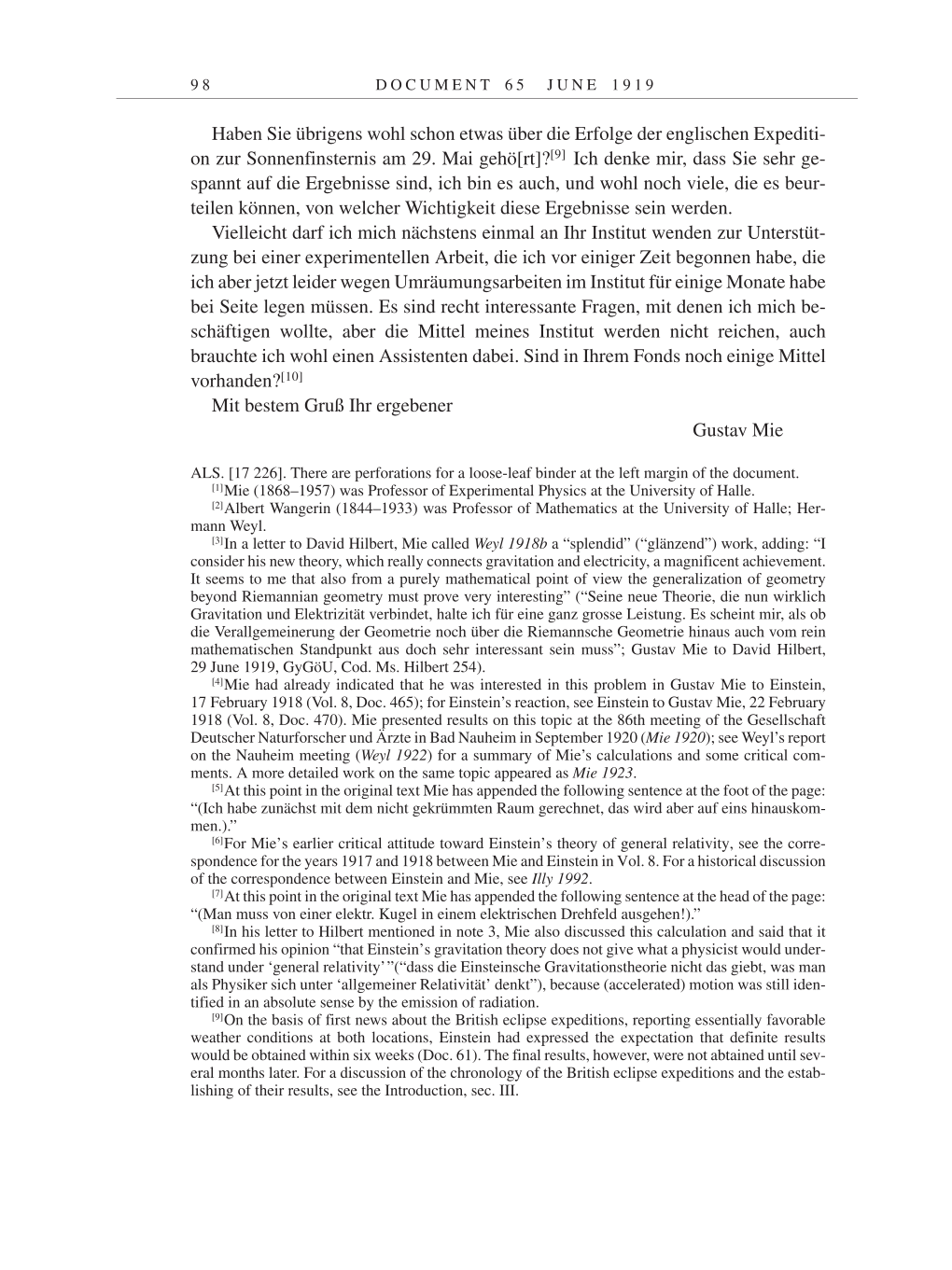9 8 D O C U M E N T 6 5 J U N E 1 9 1 9
Haben Sie übrigens wohl schon etwas über die Erfolge der englischen Expediti-
on zur Sonnenfinsternis am 29. Mai
gehö[rt]?[9]
Ich denke mir, dass Sie sehr ge-
spannt auf die Ergebnisse sind, ich bin es auch, und wohl noch viele, die es beur-
teilen können, von welcher Wichtigkeit diese Ergebnisse sein werden.
Vielleicht darf ich mich nächstens einmal an Ihr Institut wenden zur Unterstüt-
zung bei einer experimentellen Arbeit, die ich vor einiger Zeit begonnen habe, die
ich aber jetzt leider wegen Umräumungsarbeiten im Institut für einige Monate habe
bei Seite legen müssen. Es sind recht interessante Fragen, mit denen ich mich be-
schäftigen wollte, aber die Mittel meines Institut werden nicht reichen, auch
brauchte ich wohl einen Assistenten dabei. Sind in Ihrem Fonds noch einige Mittel
vorhanden?[10]
Mit bestem Gruß Ihr ergebener
Gustav Mie
ALS. [17 226]. There are perforations for a loose-leaf binder at the left margin of the document.
[1]Mie (1868–1957) was Professor of Experimental Physics at the University of Halle.
[2]Albert Wangerin (1844–1933) was Professor of Mathematics at the University of Halle; Her-
mann Weyl.
[3]In a letter to David Hilbert, Mie called Weyl 1918b a “splendid” (“glänzend”) work, adding: “I
consider his new theory, which really connects gravitation and electricity, a magnificent achievement.
It seems to me that also from a purely mathematical point of view the generalization of geometry
beyond Riemannian geometry must prove very interesting” (“Seine neue Theorie, die nun wirklich
Gravitation und Elektrizität verbindet, halte ich für eine ganz grosse Leistung. Es scheint mir, als ob
die Verallgemeinerung der Geometrie noch über die Riemannsche Geometrie hinaus auch vom rein
mathematischen Standpunkt aus doch sehr interessant sein muss”; Gustav Mie to David Hilbert,
29 June 1919, GyGöU, Cod. Ms. Hilbert 254).
[4]Mie had already indicated that he was interested in this problem in Gustav Mie to Einstein,
17 February 1918 (Vol. 8, Doc. 465); for Einstein’s reaction, see Einstein to Gustav Mie, 22 February
1918 (Vol. 8, Doc. 470). Mie presented results on this topic at the 86th meeting of the Gesellschaft
Deutscher Naturforscher und Ärzte in Bad Nauheim in September 1920 (Mie 1920); see Weyl’s report
on the Nauheim meeting (Weyl 1922) for a summary of Mie’s calculations and some critical com-
ments. A more detailed work on the same topic appeared as Mie 1923.
[5]At this point in the original text Mie has appended the following sentence at the foot of the page:
“(Ich habe zunächst mit dem nicht gekrümmten Raum gerechnet, das wird aber auf eins hinauskom-
men.).”
[6]For Mie’s earlier critical attitude toward Einstein’s theory of general relativity, see the corre-
spondence for the years 1917 and 1918 between Mie and Einstein in Vol. 8. For a historical discussion
of the correspondence between Einstein and Mie, see Illy 1992.
[7]At this point in the original text Mie has appended the following sentence at the head of the page:
“(Man muss von einer elektr. Kugel in einem elektrischen Drehfeld ausgehen!).”
[8]In his letter to Hilbert mentioned in note 3, Mie also discussed this calculation and said that it
confirmed his opinion “that Einstein’s gravitation theory does not give what a physicist would under-
stand under ‘general relativity’”(“dass die Einsteinsche Gravitationstheorie nicht das giebt, was man
als Physiker sich unter ‘allgemeiner Relativität’ denkt”), because (accelerated) motion was still iden-
tified in an absolute sense by the emission of radiation.
[9]On the basis of first news about the British eclipse expeditions, reporting essentially favorable
weather conditions at both locations, Einstein had expressed the expectation that definite results
would be obtained within six weeks (Doc. 61). The final results, however, were not abtained until sev-
eral months later. For a discussion of the chronology of the British eclipse expeditions and the estab-
lishing of their results, see the Introduction, sec. III.
